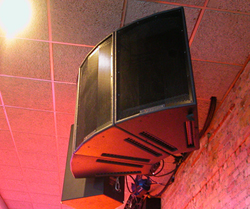
A more modest ~10 dB is realized in the upper region of the sub’s bandpass (100-125 Hz).
The use of room boundaries for subwoofer space-loading should be weighed against even coverage and imaging issues when being considered by the designer.
Dodecahedron
The device tested was a dodecahedron (12-sided) loudspeaker. These are often considered omnidirectional for the purpose of making room measurements.
Due to the very erratic response, I measured a 9-point grid (2 feet square) for each placement and averaged the results. 1/1-octave smoothing was used to produce the final plots for comparison.
This was necessary because dodecs inherently exhibit massive comb filtering at HF due to the multiple transducers, and even more so when you add the boundaries.
The HF response of the dodec is the “textbook” case for gain due to space-loading for non-coherent summation (Figure 6).

Using the free-field response as the reference (0 dB), the directivity index increases by 3 dB for each additional boundary, with DI = 9 dB representative of a corner placement.
This is a good place to point out that massive interference always results from placing low directivity devices near boundaries. In small rooms this may be considered acceptable or even desirable since it results in reduced localization of the sound source.
The use of this technique in large, live or reverberant spaces usually results in poor speech intelligibility for the same reason.
Bookshelf
The device tested was a Bag End M-6 coaxial studio monitor – a bookshelf loudspeaker.
Each measurement was made on the HF axis. The 1B measurement was made with the loudspeaker’s back against the floor (Figure 7).

The “C” and “D” measurements (from Figure 1) were made with the loudspeaker at 45 degrees to the boundary, such as it might be mounted at the intersection of a wall and low ceiling.
Note that above 3 kHz there is negligible boundary interaction, since the loudspeaker becomes so directional that the HF energy misses the boundary altogether.
At LF there is gross interaction, including “boundary dip” and some significant bumps. Equalization is sometimes used to smooth the bump and compensate for the LF rise seen below 160 Hz.
This presents a particularly bothersome dilemma since bookshelf-sized loudspeakers are the most common types used in small rooms, and it’s almost a given that they will be located near room boundaries.
